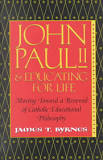Byrnes, J. T. (2002). John Paul II & educating for life: Moving toward a renewal of Catholic educational philosophy. New York: P. Lang.

Most of the book is devoted to the views and work of Karol Wojtla, who served as Pope John Paul II from 1978-2005. Byrnes reviews developments in the Catholic philosophy of education since Vatican II (1962-65, beginning under Pope John XXIII and closing under Pope Paul VI) attempted to reconcile Catholic teaching with modernity. The book gives useful background to Pope John Paul’s 1990 Ex Corde on education as well as the development of Catholic educational philosophy during a period that Brynes notes has largely been neglected.
Byrnes stresses the importance of “personalism” (viewing each person as a unique physical and spiritual being, largely in response to the horrors of WWI and the “depersonalization” of modernism in Catholic education) particularly as represented by Jacques Maritain. Maritain emphasized the role of the person in the community rather than as a selfish individual, which gave rise to a service-oriented approach to education, a commitment to individual students, and an emphasis on social justice. Byrnes notes that Wojtla/Pope John Paul II embraced both personalism and Thomism in a philosophy he terms “neo-Thomistic personalism (p. 19). So, his philosophy carried forward Vatican II in attempting to combine “the best of the old and new”. He saw education as “the process by which a person is able to embark upon the life-long process of self-fulfillment through transcendence and integration [into the community]” p. 82.
Wojtla/Pope John Paul II “is trying to explain to young people that their experience or study of the world will help the on their way to finding the truth about themselves as persons and to understand this truth” (p. 117). He understood that individual experience would influence the way in which they saw “objective truth” (thus explaining differences in opinion) but held that this should not lead to empty relativism or a belief that truth was only as one saw it (p. 117). He did, however, hold that individual freedom was critical to this search for the truth, and that students held much of the responsibility for “self-education” (p. 120). In this sense he was a proponent of what we now call “active learning”. In a quote very reminiscent of Lonergan’s self-appropriation:
“All the truths of humanity could be laid before young persons, but if they choose not to “make it their own” there is no education” (p. 121), and “education is work and must be responded to accordingly” (p. 122).
Wojtla/Pope John Paul II also emphasized that while the principle role of education is to promote “self-fulfillment” (as described above), it is also beneficial for society. Indeed, society “needs to provide education for all, not only because the dignity of the human person depends on it, but also because society’s survival depends on it” (p. 122). Despite his emphasis on the student “bearing the burden” of becoming educated, he notes the importance of parents, faculty and administrators participating in “the educational community”, and that there should be “every opportunity” for faculty development (p. 129).
Byrnes concludes that the Pope’s main contribution was bringing a clear philosophy to an education that was already happening in practice, helping it to become more “person centered by recognizing the need to be conscious of the personal experiences of each student” (p.137). He also opens the way to dialogs about academic freedom vs. the church’s “revealed truths” and those who embrace post-modernism.
Questions
- How does this primarily “bottom up” philosophy of education fit with the changes brought about by Vatican II and the modernist and post-modernist philosophy?
- Is there too great an assumption of students’ willingness to learn and appropriate material?